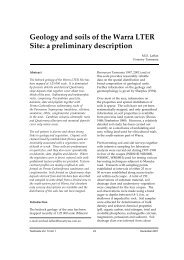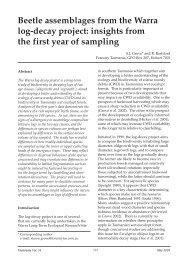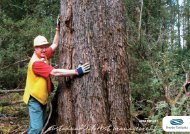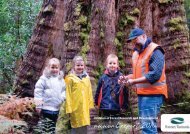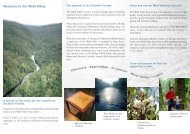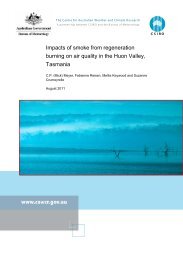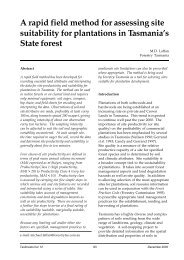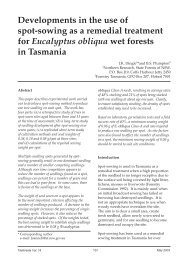The natural distribution of Eucalyptus species in Tasmania - Forestry ...
The natural distribution of Eucalyptus species in Tasmania - Forestry ...
The natural distribution of Eucalyptus species in Tasmania - Forestry ...
Create successful ePaper yourself
Turn your PDF publications into a flip-book with our unique Google optimized e-Paper software.
<strong>Eucalyptus</strong> dalrympleana is a mid- to highaltitude<br />
<strong>species</strong> generally occupy<strong>in</strong>g sites<br />
between 400 m and 800 m, and occasionally<br />
up to 1170 m (Figure 22). <strong>The</strong> lower altitude<br />
occurrences (150–400 m) are associated with<br />
cool, moist habitats, generally along the<br />
northern marg<strong>in</strong>s <strong>of</strong> its range, where<br />
<strong>in</strong>termediate forms become blurred <strong>in</strong><br />
identity with E. vim<strong>in</strong>alis. <strong>The</strong> highest<br />
altitude records are known from the Lake<br />
River catchment, east <strong>of</strong> Arthurs Lake on the<br />
Central Plateau. <strong>The</strong> ma<strong>in</strong> flower<strong>in</strong>g period<br />
is from March to May, peak<strong>in</strong>g <strong>in</strong> March and<br />
April (Figure 23).<br />
<strong>Eucalyptus</strong> dalrympleana rarely forms pure<br />
stands but is known to dom<strong>in</strong>ate small<br />
Figure 22. Altitude <strong>distribution</strong> <strong>of</strong> E. dalrympleana.<br />
n = 18<br />
Figure 23. Flower<strong>in</strong>g times for E. dalrympleana.<br />
n = 596<br />
patches <strong>of</strong> forest <strong>in</strong> the north-eastern highlands.<br />
It is more commonly a subdom<strong>in</strong>ant<br />
or m<strong>in</strong>or <strong>species</strong> <strong>in</strong> upland shrubby, wet and<br />
dry sclerophyll forests. In the wet forests, it<br />
usually occurs with E. delegatensis and, <strong>in</strong> the<br />
dry forests, E. pauciflora or E. amygdal<strong>in</strong>a are<br />
frequent dom<strong>in</strong>ants.<br />
COMMENTS: In <strong>Tasmania</strong>, E. dalrympleana<br />
is known to be phenotypically dist<strong>in</strong>ct from<br />
its ma<strong>in</strong>land counterpart (Barber 1955; Pryor<br />
and Johnson 1971), and Barber (1955) applied<br />
the term 'vim-dal' to refer to <strong>in</strong>termediates<br />
between E. dalrympleana <strong>of</strong> the Australian<br />
ma<strong>in</strong>land and E. vim<strong>in</strong>alis (Phillips and Reid<br />
1980). However, the term is widely applied<br />
by <strong>Tasmania</strong>n observers <strong>in</strong> reference to the<br />
uncerta<strong>in</strong> identity <strong>of</strong> the frequent cl<strong>in</strong>al<br />
<strong>in</strong>termediates between E. vim<strong>in</strong>alis and<br />
E. dalrympleana.<br />
<strong>The</strong> dist<strong>in</strong>ction between E. vim<strong>in</strong>alis,<br />
E. dalrympleana and E. rubida becomes obscure<br />
at altitudes between 200 m and 600 m, where<br />
the various cl<strong>in</strong>al <strong>in</strong>termediates are not easy<br />
to classify. Low-altitude outliers (i.e. < 150 m)<br />
that were not verified were considered<br />
misidentifications <strong>of</strong> <strong>in</strong>tergrad<strong>in</strong>g forms <strong>of</strong><br />
E. vim<strong>in</strong>alis (e.g. cell 4343). In the west,<br />
unverified outliers <strong>of</strong> E. dalrympleana are<br />
recorded near Strahan (cell 3633) and<br />
Waterfall Creek (cell 3830), and these same<br />
populations appear to have been ascribed to<br />
E. vim<strong>in</strong>alis by some observers. In the northeast,<br />
unverified outliers are recorded for<br />
Mount Cameron (cells 5746, 5846), west <strong>of</strong><br />
Mount Horror (cell 5545) and near Goulds<br />
Country (cell 5944). No verified occurrences<br />
are recorded on Maria Island, although<br />
Jackson (1965) <strong>in</strong>dicates the presence <strong>of</strong><br />
E. dalrympleana there (e.g. cell 5927). In the<br />
south-east, unverified outliers are recorded<br />
from near Balts Spur (cell 5723) and elsewhere<br />
on Tasman Pen<strong>in</strong>sula (cells 5523, 5622). Other<br />
unverified outliers <strong>in</strong> southern <strong>Tasmania</strong><br />
(cells 4918, 5019) are more doubtful.<br />
KEY REFERENCES: Aust<strong>in</strong> et al. (1983);<br />
Battaglia (1990b); Phillips and Reid (1980);<br />
Valent<strong>in</strong>i et al. (1990).<br />
Tasforests Vol. 8 65<br />
December 1996




